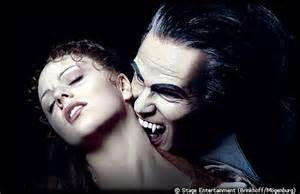
Horror stories, whether told around a campfire, in a theater, or streamed on a laptop, reflect our fears back to us. They are the stories we tell ourselves to process the dark, the shadow, the things we can’t fully comprehend. Themes change based on generational fears and concerns so that, believe it not for you non-fans, horror can provide social commentary. And often, they show us depictions of our fears about sexuality.
Of all the monsters we return to again and again, vampires speak to us about sexuality more directly than any other. They are depicted as seductive, killing in close physical contact, piercing a highly sensitive part of our body, coming in to our bedrooms at night. Often when they attack the biting process looks a lot like ecstasy rather than suffering. That’s a lot of sexy for a monster.
But they are fearful. Vampires have been in folktales for centuries. They had a wave of popularity in the late 1800s, bringing in metaphors of epidemic disease as well as the fears of being sexually seduced and all the consequences that can come from that. A large part of the fear came from depictions of women becoming sexually aggressive, predators seeking blood or life energy. Sure, the 1920s Nosferatu was not a sexy guy, but seeing him hover over sleeping women in the beds barely touching them was actually pretty titillating for movies at that time.
In the 1950s and 1960s vampires got more debonair. They were elegant and cultured but cold. Themes of being seduced and used, your humanity taken from you, became dominant. Vampires represented the foreigner, the draw of the mysterious, more dangerous than you imagine. They were amoral, perverse.
In the 1970s we saw a series of funny vampires, taking the seriousness and fear out of the image. Only squares would admit to sexual fears so we can laugh at them. But even then, the overt sexuality was seen as something laughable. Perhaps revealing our fears of being embarrassed, afraid of being seen as a caricature, our sexually overwhelming everything else.
The 80s and 90s gave us a series of sexy but lonely vampires. Truly the outsider, these vampires craved connection, they were ready for intimacy but kept from it by their monstrous nature. We saw things from these vampires perspectives and were meant to feel sympathy for them. These stories speak to fears of empty sex and the fear of feeling disconnected. Also the fear of being a danger to others was present and may have tapped into the AIDs crisis at that time.
And recently? The success of the Twilight series suggests we still have some sexual fears to sort through. With passion and obsession being firmly entwined, the seductive vampire in these stories must hold himself back for fear his passion will harm his weaker partner. Sex is a path to losing control and devouring or being devoured. Love is repressing your urges for as long as you can. Dangerous stuff. And I am not just talking about the vampires.
So what depictions of vampires will we see next? What are we afraid our sexuality will do to us? No matter what, I trust that vampires will continue to play our sexual shadow for us throughout their eternal lives.